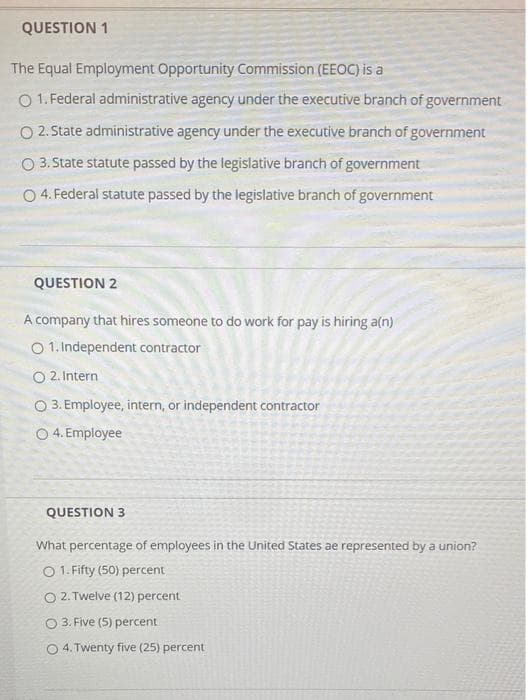QUESTION 1 The Equal Employment Opportunity Commission (EEOC) is a O 1. Federal administrative agency under the executive branch of government O 2. State administrative agency under the executive branch of government O 3. State statute passed by the legislative branch of government O 4. Federal statute passed by the legislative branch of government
QUESTION 1 The Equal Employment Opportunity Commission (EEOC) is a O 1. Federal administrative agency under the executive branch of government O 2. State administrative agency under the executive branch of government O 3. State statute passed by the legislative branch of government O 4. Federal statute passed by the legislative branch of government
Managerial Economics: A Problem Solving Approach
5th Edition
ISBN:9781337106665
Author:Luke M. Froeb, Brian T. McCann, Michael R. Ward, Mike Shor
Publisher:Luke M. Froeb, Brian T. McCann, Michael R. Ward, Mike Shor
Chapter2: The One Lesson Of Business
Section: Chapter Questions
Problem 2.4IP
Related questions
Question

Transcribed Image Text:QUESTION 1
The Equal Employment Opportunity Commission (EEOC) is a
O 1. Federal administrative agency under the executive branch of government
O 2. State administrative agency under the executive branch of government
O 3.State statute passed by the legislative branch of government
O 4. Federal statute passed by the legislative branch of government
QUESTION 2
A company that hires someone to do work for pay is hiring a(n)
O 1. Independent contractor
O 2. Intern
O 3. Employee, intern, or independent contractor
O 4. Employee
QUESTION 3
What percentage of employees in the United States ae represented by a union?
O 1. Fifty (50) percent
O 2. Twelve (12) percent
3. Five (5) percent
O 4. Twenty five (25) percent
Expert Solution
This question has been solved!
Explore an expertly crafted, step-by-step solution for a thorough understanding of key concepts.
Step by step
Solved in 2 steps

Knowledge Booster
Learn more about
Need a deep-dive on the concept behind this application? Look no further. Learn more about this topic, economics and related others by exploring similar questions and additional content below.Recommended textbooks for you

Managerial Economics: A Problem Solving Approach
Economics
ISBN:
9781337106665
Author:
Luke M. Froeb, Brian T. McCann, Michael R. Ward, Mike Shor
Publisher:
Cengage Learning

Principles of Microeconomics
Economics
ISBN:
9781305156050
Author:
N. Gregory Mankiw
Publisher:
Cengage Learning

Principles of Economics, 7th Edition (MindTap Cou…
Economics
ISBN:
9781285165875
Author:
N. Gregory Mankiw
Publisher:
Cengage Learning

Managerial Economics: A Problem Solving Approach
Economics
ISBN:
9781337106665
Author:
Luke M. Froeb, Brian T. McCann, Michael R. Ward, Mike Shor
Publisher:
Cengage Learning

Principles of Microeconomics
Economics
ISBN:
9781305156050
Author:
N. Gregory Mankiw
Publisher:
Cengage Learning

Principles of Economics, 7th Edition (MindTap Cou…
Economics
ISBN:
9781285165875
Author:
N. Gregory Mankiw
Publisher:
Cengage Learning


